West Point
The Army's Military History
West Point, NY
August 17th, 2005
For those  of
you who have had the good fortune to wander the beautiful state of New York, I
would hope that you
of
you who have had the good fortune to wander the beautiful state of New York, I
would hope that you had an opportunity to sit on a high hill and look down on
the meandering Hudson River. The serenity and beauty is unsurpassed in
emotional calming. This was not probably the most important thought for
those Revolutionary Military Generals who decided that such a beautiful place
would also be a great place to control traffic on one of the busiest waterways
in colonial America. So, with this nation in its infancy being only 2
years old, George Washington selected Thaddeus
Kosciuszko to design a fort that could control the traffic on the river and
could not be taken by river assault So well was the fort constructed that
in 1778 Washington transferred his headquarters there. By 1779 Washington
had reinforced the fort with river batteries and then dragged a heavy 150 ton
chain across the river stopping all traffic. Benedict Arnold would gain
infamy by trying to sell the floor plan of West Point to the British but would
fail. This failure would eventually place West Point into the record books
as the oldest continuously
occupied military post in America. Our tour was broken into two parts:
the museum, and the Academy itself. A placard near the front
door summed it up quite clearly:
had an opportunity to sit on a high hill and look down on
the meandering Hudson River. The serenity and beauty is unsurpassed in
emotional calming. This was not probably the most important thought for
those Revolutionary Military Generals who decided that such a beautiful place
would also be a great place to control traffic on one of the busiest waterways
in colonial America. So, with this nation in its infancy being only 2
years old, George Washington selected Thaddeus
Kosciuszko to design a fort that could control the traffic on the river and
could not be taken by river assault So well was the fort constructed that
in 1778 Washington transferred his headquarters there. By 1779 Washington
had reinforced the fort with river batteries and then dragged a heavy 150 ton
chain across the river stopping all traffic. Benedict Arnold would gain
infamy by trying to sell the floor plan of West Point to the British but would
fail. This failure would eventually place West Point into the record books
as the oldest continuously
occupied military post in America. Our tour was broken into two parts:
the museum, and the Academy itself. A placard near the front
door summed it up quite clearly:  "Man has engaged in organized
warfare since at least the
"Man has engaged in organized
warfare since at least the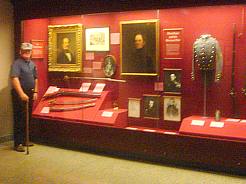 fourth millennium B.C. Since that time there has been
a war of some sort in progress almost all of the time through the present
day. Even the presence of nuclear weapons has not ended man's willingness
to go to war. Unquestionably, war-making is an aspect of human nature which will
continue as nations attempt forcibly to impose their will upon
others." It takes two powers to make war and often one is the aggressor
and the other the defender.
After hostilities begin, these roles may
switch back and forth until the more powerful of the two causes a
surrender. The study and understanding of war, what works and what does
not, has been the goal of the Academy since its inception. The lessons
learned have been taught to each class thereafter. The museum is broken down
into time periods that represent major changes in the conduct of war.
It addresses many facets including weapons, tactics, military systems, and great
leaders. The main part of the museum was dedicated to
weapons of all sorts. One of the early examples was a model of a
trebuchet. This medieval siege engine was used to smash down masonry walls
by throwing huge stones hundreds of
yards, utilizing a counterweight which flung the arm up. A sling
attached by rope or chain extended the length of the throwing arm. Fascinatingly,
it
fourth millennium B.C. Since that time there has been
a war of some sort in progress almost all of the time through the present
day. Even the presence of nuclear weapons has not ended man's willingness
to go to war. Unquestionably, war-making is an aspect of human nature which will
continue as nations attempt forcibly to impose their will upon
others." It takes two powers to make war and often one is the aggressor
and the other the defender.
After hostilities begin, these roles may
switch back and forth until the more powerful of the two causes a
surrender. The study and understanding of war, what works and what does
not, has been the goal of the Academy since its inception. The lessons
learned have been taught to each class thereafter. The museum is broken down
into time periods that represent major changes in the conduct of war.
It addresses many facets including weapons, tactics, military systems, and great
leaders. The main part of the museum was dedicated to
weapons of all sorts. One of the early examples was a model of a
trebuchet. This medieval siege engine was used to smash down masonry walls
by throwing huge stones hundreds of
yards, utilizing a counterweight which flung the arm up. A sling
attached by rope or chain extended the length of the throwing arm. Fascinatingly,
it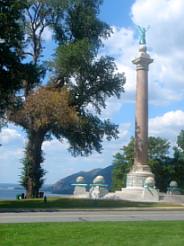 became one of the earliest weapons
of mass destruction when the bodies of
those who had died from the black plague were hurled over the walls of castles
in hopes of infecting the
became one of the earliest weapons
of mass destruction when the bodies of
those who had died from the black plague were hurled over the walls of castles
in hopes of infecting the 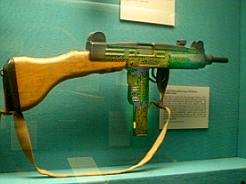 inhabitants. Another notable weapon that I found, I
actually had an occasion to fire on full automatic. The Israeli UZI submachine
gun was named for its principal designer Uziel Gal. It has a barrel of
only 10 inches but it seems even shorter because the bolt telescopes over the
rear end of the barrel. It can fire 600, 9mm round per minute. I had expected
poor accuracy giving its wide V sights and was amazed at how close a
pattern I could hold at 25 yards. It really is a superb weapon. After
completing the museum, we boarded buses for a guided tour of the campus.
We were driven to Battle Monument at Trophy Point. Here stands what is believed
to be the tallest solid piece of polished granite in the Northern
Hemisphere. It stands to honor the Army's Northern Civil War dead, for
which there are some 2200 names inscribed. Trophy Point contains a section
of the original chain floated across the river by Washington to prevent British advancement.
From there we traveled to the Cadet Chapel. This landmark, built in 1910
has served the Protestant students and faculty since conception. A strong religious
bearing has always been a mainstay in cadet life. The fort-like Gothic
design dominates the surrounding landscape. It houses
inhabitants. Another notable weapon that I found, I
actually had an occasion to fire on full automatic. The Israeli UZI submachine
gun was named for its principal designer Uziel Gal. It has a barrel of
only 10 inches but it seems even shorter because the bolt telescopes over the
rear end of the barrel. It can fire 600, 9mm round per minute. I had expected
poor accuracy giving its wide V sights and was amazed at how close a
pattern I could hold at 25 yards. It really is a superb weapon. After
completing the museum, we boarded buses for a guided tour of the campus.
We were driven to Battle Monument at Trophy Point. Here stands what is believed
to be the tallest solid piece of polished granite in the Northern
Hemisphere. It stands to honor the Army's Northern Civil War dead, for
which there are some 2200 names inscribed. Trophy Point contains a section
of the original chain floated across the river by Washington to prevent British advancement.
From there we traveled to the Cadet Chapel. This landmark, built in 1910
has served the Protestant students and faculty since conception. A strong religious
bearing has always been a mainstay in cadet life. The fort-like Gothic
design dominates the surrounding landscape. It houses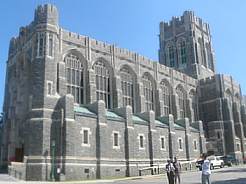 the largest church
organ in the world. Concerts are given on a regular basis throughout the year. The
sanctuary
the largest church
organ in the world. Concerts are given on a regular basis throughout the year. The
sanctuary 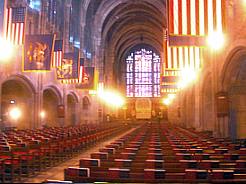 Stain Glass Window behind the altar is inscribed with the motto of the Academy "Duty, Honor, Country". The grounds have many
statues of those who achieved great feats during their service in the
Army. Our guide pointed out the statue of George Patton who graduated in 1909
and commanded the 7th Army during WWII. So the story goes, that Patton who
had less than a stellar academic record, often defended his position by declaring
that he couldn't find the library. This became a common joke during his time at
the Academy. Because of this, his statue was placed standing with its back to
the library. And so we rounded out our tour of this most fascinating center
of higher learning. Even for those who are not into the military scene,
the serenity and beauty of the grounds is worth the trip.
Stain Glass Window behind the altar is inscribed with the motto of the Academy "Duty, Honor, Country". The grounds have many
statues of those who achieved great feats during their service in the
Army. Our guide pointed out the statue of George Patton who graduated in 1909
and commanded the 7th Army during WWII. So the story goes, that Patton who
had less than a stellar academic record, often defended his position by declaring
that he couldn't find the library. This became a common joke during his time at
the Academy. Because of this, his statue was placed standing with its back to
the library. And so we rounded out our tour of this most fascinating center
of higher learning. Even for those who are not into the military scene,
the serenity and beauty of the grounds is worth the trip.
*** THE END ***
